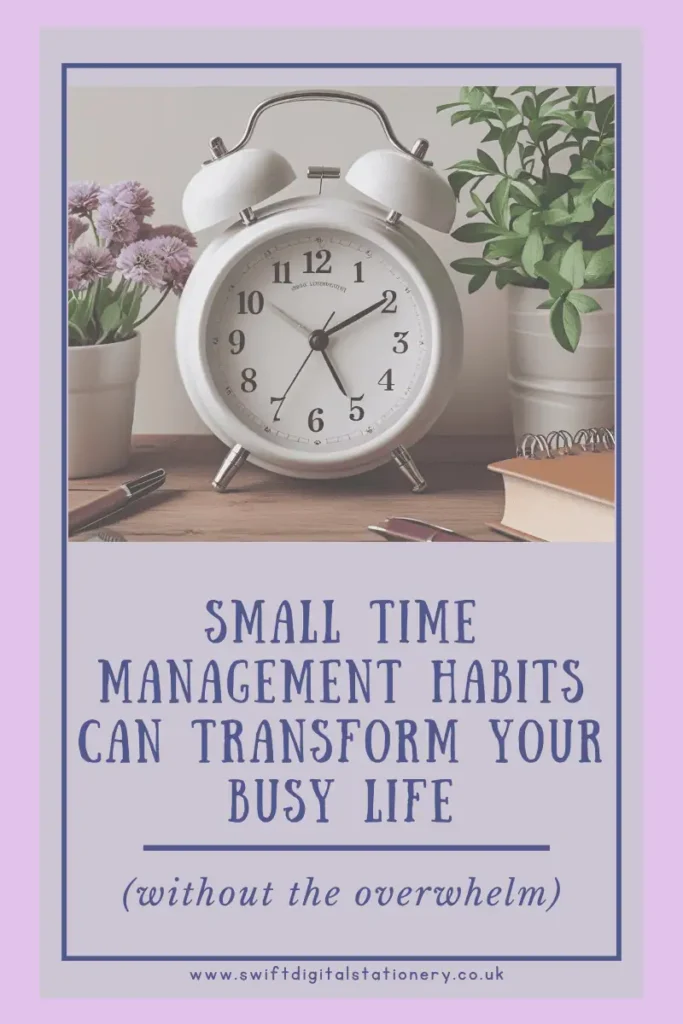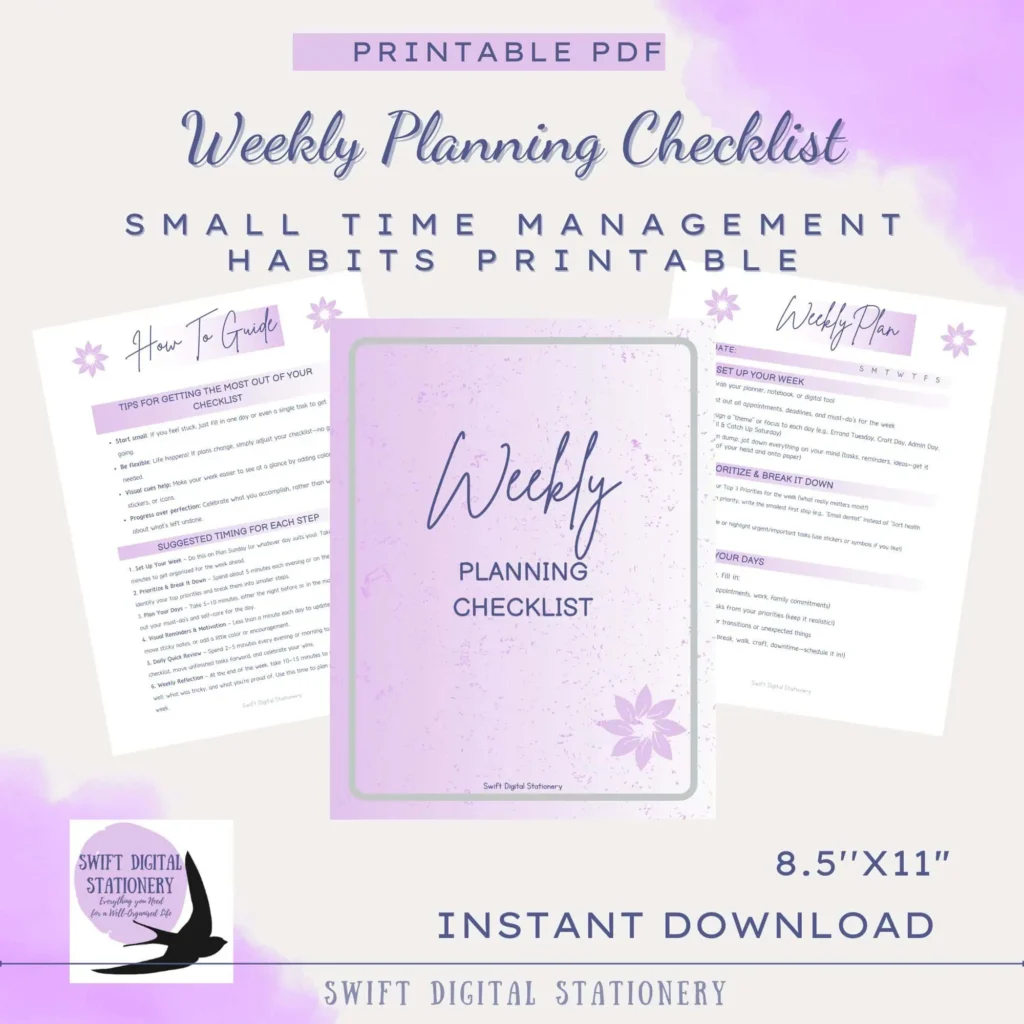How Small Time Management Habits Can Transform Your Busy Life (Without the Overwhelm)
Welcome! Grab your tea and let’s chat about time management.
I’m so glad you’re here. Today, I want to share some of the simple, real-life time management habits that have helped me feel more in control, less stressed, and yes—actually get things done without losing my mind. Think of this as a friendly chat over a cup of tea (or coffee if that’s your thing).
If you’ve ever felt overwhelmed by your to-do list or like there just aren’t enough hours in the day, you’re in the right place.

Why Time Management Doesn’t Have to Be Complicated
Let’s be honest: time management often gets a bad rap. It sounds like something only super-organized people can do, or that it means cramming every minute with tasks and feeling guilty when you don’t.
But here’s a little secret: it’s really about making space for what matters most and being kind to yourself along the way.
My Favourite Time Management Routine: The Organised Mum Method (TOMM)
Over the past year, I’ve been following The Organised Mum Method, and it’s been a game changer for me. It’s simple, flexible, and perfect for busy women who want to keep their homes manageable without spending hours cleaning or stressing over missed tasks.
Here’s how it works (in simple terms):
- Level 1 (Daily Essentials – 15 minutes): These are the must-do tasks that keep your home ticking over—washing dishes, vacuuming high-traffic areas, a quick bathroom clean, and a load of laundry. Just 15 minutes a day, no more.
- Level 2 (Room Focus – 30 minutes): Each day, you focus on one room for a deeper clean. For me, Monday is living room day, Tuesday bedroom, Wednesday bathroom, Thursday kitchen.
- Level 3 (Friday Focus – 30 minutes): This is your weekly “big job” day. It rotates each week and might be something like cleaning windows, tackling a cupboard, or a spring-clean style task.
Why This Works for Me (And Might Work for You)
- Short, manageable chunks: 15 or 30 minutes feels doable, even on busy days.
- Consistency over perfection: Missing a day isn’t the end of the world. The goal is progress, not perfection.
- Structure with flexibility: Having a plan helps me stay on track, but I can adjust if life throws a curveball.
- Less overwhelm: Breaking big cleaning tasks into small daily actions means my home feels more manageable and less chaotic.
- Mental peace: Knowing I have a plan reduces stress and frees up mental space for other things.
How I Plan My Week (Spoiler: It’s Not Fancy!)
Every Sunday evening, I sit down with my notebook and review the past week. I jot down what I missed, what worked well, and what I want to focus on next week. I give my days themes—like Errand Tuesday or Chill & Catch Up Saturday—which helps me batch similar tasks and keep things simple.
Each night, before closing my laptop, I glance over my list for the next day. It’s like giving myself a gentle heads-up, so I’m not scrambling in the morning.
How to Turn Time Management Advice Into Real-Life Actions (Especially with AuDHD)
If you’ve ever read advice about “breaking tasks into manageable chunks” or “working in short bursts” and thought, “Okay, but how do I actually do that?” — you’re not alone. For many of us with AuDHD (or ADHD), it can be tricky to translate these tips into real, practical steps.
Here’s how I make those ideas work for me, with examples you can try too:
1. Short, Manageable Chunks—What Does That Actually Mean?
Instead of “clean the kitchen,” try:
- Pick one part: “Wipe the counters for 5 minutes.”
- Set a timer: Use your phone or a kitchen timer for just 10–15 minutes. When it goes off, you’re done (unless you want to keep going).
- Micro-goals: “Put away just the clean dishes.” If that’s all you do, it’s a win!
Tip: For anything that feels big, ask: “What’s the tiniest step I could take right now?”
2. Batching Tasks—How Do You Actually Do That?
If “batching” sounds vague, here’s how you can apply it:
- Named Days: Like I do, assign certain days for certain types of tasks (Errand Tuesday, Craft Day, etc.).
- Housework Example: On “Bedroom Day,” only focus on things in the bedroom—make the bed, pick up laundry, dust one shelf.
- Email Example: Instead of checking email all day, set a 20-minute block after lunch to reply to messages.
Tip: Write down your batches on a sticky note or planner page so you can see them at a glance.
3. Timers and Sprints—How Does That Work?
- Set a timer for 15–25 minutes (the Pomodoro Technique). Work on just one thing until the timer rings, then take a 5-minute break (stretch, make tea, look out the window).
- Repeat if you feel up to it. If not, that’s okay—you did a focused “sprint,” and that’s more than nothing.
Tip: Use a fun timer or app, or even a playlist that’s the length of your sprint.
4. Visual Reminders and “Out of Sight, Out of Mind”
- Keep a visual to-do list: Use a whiteboard, sticky notes, or a paper planner that stays open on your desk or kitchen table.
- “Future You” Board: For bigger projects, write each small step on a sticky note and move it to a “Done” column when finished.
- Clocks & Timers: Place a clock where you can see it while you work—this helps with “time blindness.”
5. Buffer Time—What Does That Look Like?
- Add extra time between tasks: If you think it’ll take 10 minutes to get ready, plan for 15–20.
- Appointments: If you need to leave at 9:00, set your alarm for 8:30 and aim to be out the door by 8:45.
- Transition rituals: Give yourself 5 minutes to stretch or have a drink between tasks.
6. Consistency Over Perfection—How to Be Kind to Yourself
- Missed a day? Just pick up where you left off, no guilt.
- Celebrate tiny wins: Did you do one thing today? That counts!
- Track progress visually: Colour in a box, move a sticky note, or cross off your list.
Real-Life Example: My Housework Routine
Here’s how I use these ideas in my own life:
- Level 1 (Daily, 15 min): I set a timer and only do basics—dishes, vacuum, one bathroom wipe, one load of laundry. If I only get two done, that’s fine.
- Level 2 (Room Focus): Monday is living room day. I’ll dust one shelf, fluff the cushions, and maybe tidy the coffee table. That’s enough!
- Level 3 (Friday Focus): Pick one “bigger” job—like cleaning out a drawer. I break it down: “Take everything out,” “Wipe inside,” “Put back only what I want.”
Tips for Building Your Own Time Management Routine
- Start small: Pick one habit to try this week—maybe just 15 minutes of daily tidying.
- Be kind to yourself: Missed a day? No worries. Just pick up where you left off.
- Use themed days: Group similar tasks together to save time and brainpower.
- Plan weekly: Spend a little time each week reviewing and adjusting your plan.
- Celebrate progress: Every small win counts—give yourself credit!

To help you put these habits into action, I’ve created a printable that breaks down small time management routines into easy steps. Download it below and keep it handy for daily inspiration!
Click here to download your free Small Time Management Habits printable!
Want More Practical Tips?
I’ve also put together a quick blog post with 5 time management hacks for busy women that you might find helpful.
Check it out here!
Let’s Keep the Conversation Going
What’s one thing you wish you had more time for this month? Drop me a comment below or pop into our Facebook group to share your thoughts. I love hearing from you!
Thanks for spending this time with me. Remember, it’s not about doing everything perfectly—it’s about creating a rhythm that feels good for you.
Here’s to small steps, big changes, and plenty of tea along the way!




